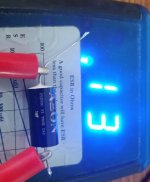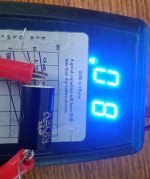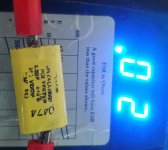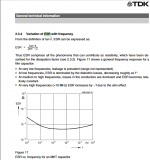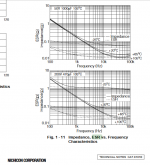<snip>
3 ohms?!?
Yup! Look at low value bi-polar electrolytic datasheets and you will see ones in that range when new as well as ones that are somewhat less.
It's a dedicated ESR meter, it is using a frequency of around 100Khz for the measurements 🙂
Tony.
Tony.
Small bypass caps are to short high freqs above where the large cap becomes inductive. Probably useless in speaker xovers.
Okay. So which construction gets a low esr at reasonable cost in the 1-2mfd range? I always went with fancier stuff at low ranges because of longer life and more consistency, but if the esr ramps up like that, it's another reason. Can't test any small fancies, they're all in speakers, and the usual suspects(PE,Mad)don't list esr specs handily.
I have some non fancy axon polyprops. Nothing fancy to compare with. But I would expect similar values from other polyprops.
Edit ok just measured a random polyester 2.2uf and it's lower than the 3.6uf polyprop. So not sure my comment above stands..
1uf 0.13 esr
3.6uf 0.08 esr
Edit ok just measured a random polyester 2.2uf and it's lower than the 3.6uf polyprop. So not sure my comment above stands..
1uf 0.13 esr
3.6uf 0.08 esr
Attachments
Last edited:
It's a dedicated ESR meter, it is using a frequency of around 100Khz for the measurements 🙂
Tony.
I just sold my Blue ESR meter because I picked up a Tonghui meter that measures an assortment of parameters at selectable test frequencies as low as 100Hz (1kHz is also an option). As I eventually discovered for myself, the Blue ESR meter's best use is as a pass/fail meter when probing for bad electrolytic caps in power supplies.
The problem with measuring ESR is that it actually rises with frequency, so an ESR measument using a 100kHz test frequency is not going to reflect the ESR at 1kHz, which is a more relevant frequency to test at (for both ESR and L) when testing loudspeaker crossover components. Of course, the blue Bob Parker ESR meter is still going to reflect that a poly cap has lower ESR than an electrolytic of the same value but you don't need a meter to tell you that.
Another problem with the 100kHz test frequency of the blue ESR meter is it can't accurately measure the ESR of caps below about 1uF, as the Xc of such low value caps swamps the ESR at that frequency. This wasn't really seen as a problem when the Blue meter was designed because, as mentioned before, it's intended use is for checking electrolytics (which are very seldom seen in values below 1uF).
One other matter (that you already observed) is that when comparing capacitors of similar composition but differing capacitance, the larger value capacitor will always have the lower ESR. So bypassing a 10uf poly cap with a costly .1uf poly/teflon/foil/whatever cap is virtually pointless because, with the much higher Xc and ESR, it is actually the small value cap that is being bypassed by the large value cap. The small cap is virtually out of the circuit. It is only in the case of bypassing a high value electrolytic capacitor with a small value poly cap that the smaller cap might have the lower ESR. And even in this case, the crossover network still takes a lifespan hit due to the electrolytic being in there.
Be wary of swapping out electrolytic caps in shunt positions. It's not too difficult for an engineer to factor their increased ESR into the network. Swapping in a cap of lower ESR into this kind of design is actually going to do more harm than good.
Lastly, one advantage electrolytic capacitors have over poly caps is their comparatively smaller size for a given value. A 200uf poly cap is going to be much larger and have longer leads. It's been shown that the increased size of the poly cap makes it a much more effective antenna for picking up 50/60Hz noise from the mains. Not a problem for mid and high frequency networks, but it is worth considering when looking at woofer networks in full-range loudspeakers.
Yes the blue esr was designed to find bad electros. I had noticed it seems to be a bit sporadic for values under 1uF.
I did some searching as I seem to recall I was originally concerned about the high frequency being not relevant for audio range but had decided it wasn't an issue. I turned up a couple of cap manufacturers sheets. One from TDK (film caps) and the other for Nichicon (electrolitic's) Both show if anything the esr measured at 1Khz will be higher than measured at 100Khz (but not significantly). I've attached snippets.
Not saying that the blue ESR is necessarily highly accurate, but I don't think 1Khz vs 100Khz for testing seems to be a big issue?
nichicon sheet http://www.nichicon.co.jp/english/products/pdf/aluminum.pdf
tdk sheet https://en.tdk.eu/download/530754/b...d34f6000e/pdf-generaltechnicalinformation.pdf
Tony.
I did some searching as I seem to recall I was originally concerned about the high frequency being not relevant for audio range but had decided it wasn't an issue. I turned up a couple of cap manufacturers sheets. One from TDK (film caps) and the other for Nichicon (electrolitic's) Both show if anything the esr measured at 1Khz will be higher than measured at 100Khz (but not significantly). I've attached snippets.
Not saying that the blue ESR is necessarily highly accurate, but I don't think 1Khz vs 100Khz for testing seems to be a big issue?
nichicon sheet http://www.nichicon.co.jp/english/products/pdf/aluminum.pdf
tdk sheet https://en.tdk.eu/download/530754/b...d34f6000e/pdf-generaltechnicalinformation.pdf
Tony.
Attachments
Last edited:
Let's not forget that all electrolytics age over time, capacitance values and working voltage drop and they can become leaky too. Capacitors should be rated at a significant working voltage that is above the expectant peak to peak output voltage of the amplifier when driven close to clipping. They should also be capable of passing the high currents that go with those peak to peak voltage differences. Small, compact N.P electrolytics are likely to 'pop' if they are subjected to such abuse. Either parallel up small values to make up the final value or get a non polar that is sufficiently engineered for high power use.
C.M
C.M
Hi There! This is my first post. Brief introduction i have a pretty basic and limited knowledge of HiFi equipment and a fairly basic understanding of electronics (always keen to learn though).
Recently went out and bought an Onyko A9010 Amp and a set of Q Acoustics 3020 only to be left underwhelmed by the speakers performance i started remember my love for older HiFi gear and headed straight to Ebay, Google and Gumtree to see what i could find, a few days later i had a pair of very nice coniditon Technics SB-X3 speakers for peanuts. Got them home and plugged them in and on the whole was fairly impressed with their sound.
Not being satisfied i got the tinkering urge and started to pull apart check the internal speaker connections, crossover, and to give them a general spruce up. I them started reading into the capacitor replacement for the crossover and that generally electrolytic caps are bad past 20 years or so. So having never modified a crossover ever i started googling furiously for the types of capacitors to be hit with a minefield of options, prices and types. The SB-X3 crossover features 4 NPE's, 4 Inductors and one Wire Wound resistor in series with the woofer cap. From my week of googling i opted for some Ansar Supersound polypropylene as its suggested they are vastly superior to any electrolytic capacitor in an audio path and they sat at a reasonable price point.
I have just soldered them on today, expecting to be greeted with an uplift in treble brightness and clarity (seems to be the main enhancement NPE vs poly), but only to hear a muddy ruined speaker.
Hours and hours of head scratching and checking soldering i cant figure it out guys. With the new capacitors in place the Mid cone and tweeter's output are effectively reduced by 50-75% over NPE's. More research and reading into ESR issues on Polys vs NPE's i then decided to add an inline wirewound resistor in series with the cap, i tried 0.1, 0.22, 0.5, 1.0 Ohm and none made a discernable difference. THe woofer output seems unacfected and the volume seems inline with normal on the Poly cap, although people seem to leave NPE's for the woofer and use Polys for the tweeter i just decided to renew them all. I have bypassed the speakers mid/tweeter attenuators and that also made no difference.
Where am i going wrong guys? I don't have the knowledge to know what to probe or how to trouble shoot futher. I want to make it work.
I Have attached some pictures of the Crossover. The link to this manual shows the crossover schematic and PCB layout. Thanks for any help you an offer!
Technics SB-X3 - Linear Phase Speaker System - HiFi Engine
TECHNICS SB-X3 - Service Manual Immediate Download
I noted from the first photo (of the crossover) it appears that the coils are bolted to the circuit board with steel threads,nuts and washers. These are likely to change the inductance of each coil somewhat from the original crossover design as on paper, it may not be audible but gluing them to the board might be a better choice.
C.M
It makes more sense to measure ESR at the frequencies in the passband of the driver. 1 kHz ESR measurement difference between 3,3 uF NPE and a PP is significantly larger than at 4 kHz. The impedance plots match each other well at higher freqiencies and start to diverge at lower ones.
I noted from the first photo (of the crossover) it appears that the coils are bolted to the circuit board with steel threads,nuts and washers. These are likely to change the inductance of each coil somewhat from the original crossover design as on paper, it may not be audible but gluing them to the board might be a better choice.
C.M
And orient them 90 degrees to each other.
I've just checked the order, you guys nailed it i cocked the order up as you've said (0.22uF instead of 2.2uF and 0.47uF instead of 4.7uF).
Will purchase correct and report back. Thanks for spotting guys i wouldnt have noticed that for a while!
Einric i will check your thread out, they are great speakers arent they?
Hey man, you have never reported back here how it turned out for you with proper value capacitors 🙂
I just registered on the forum to remind you about that :-D
The things is, I have a pair of SB-X3s, just bought them recently, and even though I'm satisfied with warmth and fatness of their sound, I noticed some lack of dynamics in high end at times. It mostly occurs when played loud and there is a lot of loud hi-freq sounds, percussions especially, in a small time frame - then they sound rather thin, dissociated from the low end, a bit too sharp also. For some music, mostly containing synth pads, they can sound a bit muddy. I though that was due to the fact that woofer goes all the way up to 2000hz so it paints the sound picture in such a way. You could see right away why I'd be interested in outcome of your intervention now that I've stumbled upon it 🙂
I actually did come to terms with them being as they are but I do combine them with pair of esi aktiv home monitors placed higher and SB-X3s placed lower in the room. It does work out nice for listening to music in living room environment as esi aktiv monitors make up for the clarity in high-end and SB-X3s do give a rich sound none the less of this capacitor business.
BUT, I do have a feeling SB-X3s can give overall juicier sound themselves and this thread comes as a missing link in this theory. If NPE capacitors do go bad with time, as it is said they do, replacing them with newer tech could do wonders here. Furthermore I've even read review on some other vintage technics speakers before buying SB-X3s and powerful bass and thin / sharp highs were mentioned in context of "ah these are one of the nothing special type speakers made by technics" but that might just be aged NPE capacitors speaking there also.
Anyhow a dear friend of mine, audio fantic, has been pimping audio stuff, mixers etc. with better components, capacitors included so I just need to find out is it worth the effort for the SB-X3s.
Thanx!
- Home
- Loudspeakers
- Multi-Way
- Vintage Crossover Polypropylene upgrade...sounds awful! (help)
